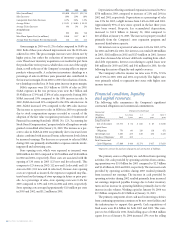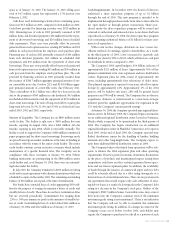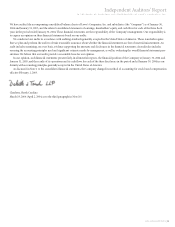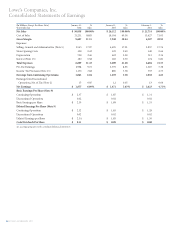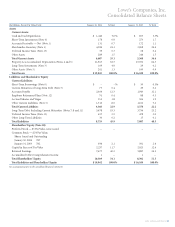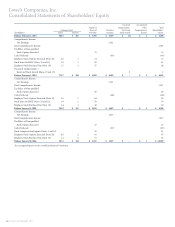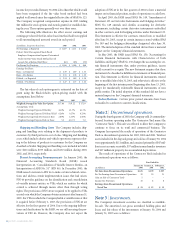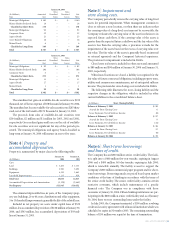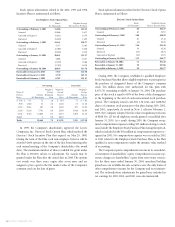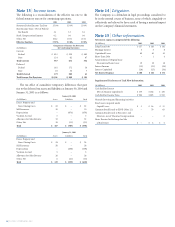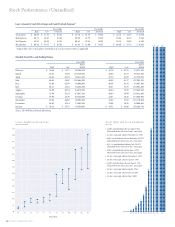Lowe's 2003 Annual Report Download - page 32
Download and view the complete annual report
Please find page 32 of the 2003 Lowe's annual report below. You can navigate through the pages in the report by either clicking on the pages listed below, or by using the keyword search tool below to find specific information within the annual report.
30 LOWE’S COMPANIES, INC.
Note 1
|
Summary of significant
accounting policies.
The Company is the world’s second largest home improvement
retailer and operated 952 stores in 45 states at January 30, 2004.
The following are those accounting policies considered to be
significant by the Company.
Fiscal Year The Company’s fiscal year generally ends on the
Friday nearest the end of January. Each of the fiscal years presented
contains 52 weeks.All references herein for the years 2003, 2002 and
2001 represent the fiscal years ended January 30, 2004, January 31,
2003 and February 1, 2002, respectively.
Principles of Consolidation The consolidated financial state-
ments include the accounts of the Company and its subsidiaries, all
of which are wholly owned. All material intercompany accounts
and transactions have been eliminated.
Use of Estimates The preparation of the Company’s financial
statements in accordance with accounting principles generally
accepted in the United States of America requires management to
make estimates that affect the reported amounts of assets, liabilities,
revenues and expenses and related disclosures of contingent assets
and liabilities. The Company bases these estimates on historical
results and various other assumptions believed to be reasonable, the
results of which form the basis for making estimates concerning the
carrying values of assets and liabilities that are not readily available
from other sources. Actual results may differ from these estimates.
Cash and Cash Equivalents Cash and cash equivalents include
cash on hand, demand deposits and short-term investments with
original maturities of three months or less when purchased.
Investments The Company has a cash management program
which provides for the investment of cash balances not expected to
be used in current operations in financial instruments that have
maturities of up to 10 years. Investments, exclusive of cash equiva-
lents, with a maturity date of one year or less from the balance
sheet date or that are expected to be used in current operations, are
classified as short-term investments. All other investments are clas-
sified as long-term. Investments consist primarily of money
market preferred stocks, municipal obligations, agency bonds, cor-
porate notes and stocks and mutual funds.
The Company has classified all investment securities as avail-
able-for-sale, and they are carried at fair market value. Unrealized
gains and losses on such securities are included in accumulated
other comprehensive income in shareholders’ equity.
Derivative Financial Instruments The Company does not
use derivative financial instruments for trading purposes.
Accounts Receivable The majority of accounts receivable arise
from sales to commercial business customers. The allowance for
doubtful accounts is based on historical experience and a review of
existing receivables. The allowance for doubtful accounts was $7
million at January 30, 2004 and January 31, 2003.
Sales generated through the Company’s private label credit
cards are not reflected in receivables. Under an agreement with
General Electric Company and its subsidiaries (GE), consumer
credit is extended directly to customers by GE. All credit program-
related services are performed and controlled directly by GE. The
Company has the option, but no obligation, at the end of the
agreement to purchase the receivables. The total portfolio of
receivables held by GE approximated $3.8 billion at January 30,
2004 and $3.3 billion at January 31, 2003.
Merchandise Inventory Inventory is stated at the lower of cost
or market using the first-in, first-out method of inventory
accounting. The cost of inventory also includes certain costs asso-
ciated with the preparation of inventory for resale.
The Company records an inventory reserve for the loss associated
with selling discontinued inventories below cost. This reserve is based
on management’s current knowledge with respect to inventory levels,
sales trends and historical experience relating to the liquidation of
discontinued inventory. Management does not believe the
Company’s merchandise inventories are subject to significant risk of
obsolescence in the near-term, and management has the ability to
adjust purchasing practices based on anticipated sales trends and
general economic conditions. However, changes in consumer pur-
chasing patterns could result in the need for additional reserves. The
Company also records an inventory reserve for the estimated shrink-
age between physical inventories. This reserve is based primarily on
actual shrink results from previous physical inventories. Changes in
actual shrink results from completed physical inventories could result
in revisions to previously estimated shrink expense. Management
believes it has sufficient current and historical knowledge to record
reasonable estimates for both of these inventory reserves.
Property and Depreciation Property is recorded at cost. Costs
associated with major additions are capitalized and depreciated.
Capital assets are expected to yield future benefits, have useful lives
which exceed one year and have minimum acquisition cost based
on the type of asset involved. The total cost of a capital asset gen-
erally includes all applicable sales taxes, delivery costs, installation
costs and other appropriate costs incurred by the Company in the
case of self-constructed assets. Upon disposal, the cost of proper-
ties and related accumulated depreciation are removed from the
accounts with gains and losses reflected in earnings.
Depreciation is provided over the estimated useful lives of the
depreciable assets. Assets are depreciated using the straight-line
method. Leasehold improvements are depreciated over the shorter
of their estimated useful lives or the term of the related lease.
Impairment/Store Closing Losses related to impairment of
long-lived assets are recognized when circumstances indicate the
carrying values of the assets may not be recoverable. The Company
periodically reviews the carrying value of long-lived assets for
potential impairment. When management commits to close or
relocate a store location, or when there are indicators that the car-
rying value of a long-lived asset may not be recoverable, the
Company evaluates the carrying value of the asset in relation to its
expected undiscounted future cash flows. If the carrying value of
the assets is greater than the expected undiscounted future cash
Notes to Consolidated Financial Statements
years ended january 30, 2004, january 31, 2003 and february 1, 2002




